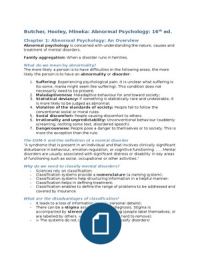Butcher, Hooley, Mineka: Abnormal Psychology: 16th ed.
Chapter 1: Abnormal Psychology: An Overview
Abnormal psychology is concerned with understanding the nature, causes and
treatment of mental disorders.
Family aggregation: When a disorder runs in families.
What do we mean by abnormality?
The more likely a person is to have difficulties in the following areas, the more
likely the person is to have an abnormality or disorder:
1. Suffering: Experiencing psychological pain. It is unclear what suffering is
(to some, mania might seem like suffering). This condition does not
necessarily need to be present;
2. Maladaptiveness: Maladaptive behaviour for and toward society;
3. Statistical deviancy: If something is statistically rare and undesirable, it
is more likely to be judged as abnormal;
4. Violation of the standards of society: People fail to follow the
conventional social or moral rules.
5. Social discomfort: People causing discomfort to others.
6. Irrationality and unpredictability: Unconventional behaviour (suddenly
screaming, reciting some text, disordered speech).
7. Dangerousness: People pose a danger to themselves or to society. This is
more the exception than the rule.
The DSM-5 and the definition of a mental disorder
“A syndrome that is present in an individual and that involves clinically significant
disturbance in behaviour, emotion regulation, or cognitive functioning. . . . Mental
disorders are usually associated with significant distress or disability in key areas
of functioning such as social, occupational or other activities.”
Why do we need to classify mental disorders?
- Sciences rely on classification;
- Classification systems provide a nomenclature (a naming system);
- Classification systems help structuring information in a helpful manner;
- Classification helps in defining treatment;
- Classification enables to define the range of problems to be addressed and
covered by insurance.
What are the disadvantages of classification?
- It leads to a loss of information (mainly personal details);
- There can be a stigma associated with a diagnosis. Stigma is
accompanied by stereotyping and labelling (people label themselves, or
are labelled by others, which is a label that is hard to remove).
- > The systems do not classify people, they classify disorders!
, How can we reduce prejudicial attitudes toward the mentally ill?
- Even though people understand that mental illnesses are caused in the
brain, this does not mean they are prejudiced less toward them;
- Stigma could be reduced by interacting more with mentally ill people.
However, when people did this, a study found that people were more
psychophysiologically aroused; this might cause avoidance.
How does culture affect what we consider abnormal?
Culture can shape the clinical presentation of disorders like depression. People in
China will mainly describe physical symptoms.
Culture-specific disorders
- Taijin Kyofusho: Japanese anxiety disorder (people are afraid to offend
others with their body);
- Ataque de nervios: Latino disorder in which one has one episode of
screaming and very strange behaviour, triggered by a trauma, and then
goes back to normal.
How common are mental disorders?
Important to know because:
- Mental health planners need to allocate resources;
- May provide clues to the cause of the disorders.
Prevalence and incidence
Epidemiology: The study of the distribution of diseases, disorders, or other
health-related behaviours in a given population.
Prevalence: The number of active cases in a population during an given period
of time.
Point prevalence: The estimated proportion of the actual, active cases of
a disorder in a population at a given point in time.
1-year prevalence: Everyone who experienced depression at any point in
time throughout the entire year would be counted.
Lifetime prevalence: The number of people who have had a particular
disorder at any time in their lives.
Incidence: The number of new cases that occur over a given period of time.
Prevalence estimates for mental disorders
See table 1.1, p. 13.
Comorbidity: The term used to describe the presence of two or more disorders
in the same person.
Treatment
People often do not seek treatment, wait years to seek help, solve problems
themselves. Also, they are treated by the family physician, or are not treated
inside the hospital (outpatient instead of inpatient).






